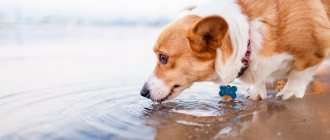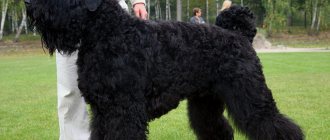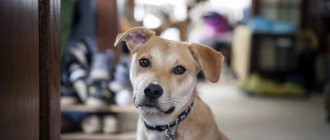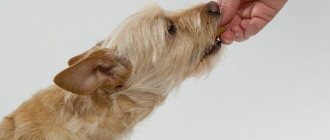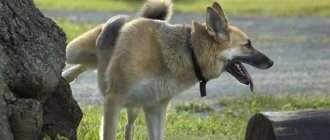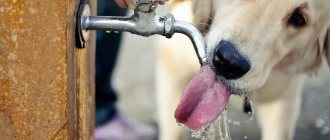There are often cases when a dog, especially if it is small, can be taken with you. However, after reading this article, you will find out how long a dog can live without food.
How long can a dog live without food?
As we said at the beginning of the article, a dog can live without food even for several weeks, everything will depend on the situation. Dogs are quite stable animals, they can hold on for a long time, because there are different cases. For example, a dog was abandoned or trapped after an earthquake. Of course, the stability of a healthy adult dog will not be the same as that of a puppy, older dog or a sick dog, and size also plays an important role.
On the other hand, although you can survive without food, water is important. Without water, death occurs in a matter of days. But as we say, these are survival cases. In our home, if we notice that our dog is not eating, we should go to the vet . If it is a puppy or a very old dog, sick or if we notice symptoms such as diarrhea, fever or vomiting , a consultation should be carried out as soon as we notice that the dog is not eating. In a healthy dog we can wait a day, perhaps this is temporary discomfort.
Personal participation
Of course, this imposes responsibility on each of us. If a dog has been howling desperately nearby for several days, you should definitely go and make sure that the owners are there and have a conversation with them. If it turns out that the animal has been abandoned, then care should be taken to provide it with food and water, and also inform the nearest shelter. Perhaps today the dog will be transferred to foster care, where they will begin to look for a new family for him.
It is difficult to definitively answer the question of how long a dog can live without food. It depends on her health, age and many other factors. When under stress, she may not touch food or water for days.
Why doesn't my dog eat?
Sometimes a dog stops eating for psychological reasons . For example :
- A dog has recently arrived at your home : Due to the animal's changes and adaptation to its new home, the dog may go several days without eating or even urinating.
- Dietary changes : A dog may also temporarily stop eating if we suddenly change the food. It is always best to make changes to our pet's diet gradually.
- Illnesses : If our furry friend needs to take a certain diet due to illness, it is likely that he will also stop eating.
How much water does an animal need?
Water dissolves and transports nutrients. That is, for the normal functioning of all organs and systems, a sufficient amount of it is needed. During illness, in hot weather, with vomiting and diarrhea, fluid reserves in the body quickly melt. If these conditions are not corrected, the dog will die almost within 24 hours.
The animal's need for water is 40 ml per 1 kg of weight. For an adult watchdog, this is approximately 2.5 liters per day. Half should come with water, and the other half with food.
How long can a sick dog live without food?
Regarding how long a dog can live without food when it is sick, there are differences depending on the pathology and circumstances . Seriously ill dogs will often stop eating and, in addition, numerous diseases will directly affect the digestive system, causing vomiting, diarrhea or pain. This prevents them from feeding normally as they will vomit up anything they swallow.
In these cases, we must hospitalize our friend. In this situation, the dog can survive 48-72 hours without food . The veterinarian will resume feeding wet food prepared for recovering animals. This food is very nutritious, tasty and easy to dilute for administration with a syringe.
If the dog is still not eating, tube feeding will be considered. As the dog's health improves, we may notice that he has difficulty regaining his appetite.
Consequences
Even if an animal survives after a long fast and dehydration, irreversible processes may begin in its body. The dog will need the help of a veterinarian, but even in the best scenario, dystrophy, rickets and digestive problems will remain with it forever. In most cases, dogs' paws fail: first the hind paws, and then the front paws.
If you find an emaciated animal, immediately take it to a doctor. Don't try to feed him yourself. Of course, if you find a dog who hasn't eaten for just a day or two, then a warm cup of porridge with meat is the best thing you can offer him. This also applies to pets who refuse to eat on their own. If on the second day the dog has not touched the bowl, you need to immediately take him to the veterinarian.
Is it bad to leave a dog without food for a day?
After seeing how many days a dog can live without food, we might think that it can easily survive 24 hours without food. But just because it will physically survive hunger does not mean it can be done.
The fact that a dog stops eating for one day due to specific discomfort does not mean that we voluntarily stopped feeding the dog. We should not do this to any dog, especially puppies or sick dogs, unless they are suffering from food poisoning and the vet recommends a few hours of fasting. Dogs should eat one or more times a day.
How to help an exhausted animal yourself
A dog should not be left without food, even for a day.
Sometimes it is not possible to show the dog to a veterinarian. In this case, you have to rely only on yourself. It is possible to save an animal that has been starving for several days. Here are the steps you should take:
- A severely malnourished dog needs to inject 10 ml of saline solution under the skin every hour. This will help the animal hold out until the appointment with the doctor. Upon arrival, doctors must prescribe a drip for the animal to compensate for the lack of vitamins in the body.
- If an exhausted dog has been starving for only a couple of days, then you can safely feed him high-calorie food.
A dog should not be left without food even for a day. It is extremely important that she has fresh, nutritious food and clean water every day. If there is no feeding, the dog will quickly get sick and die.
How to feed a dog that doesn't want to eat
Regardless of how many days a dog can go without food, the truth is that our job is to get a dog that is showing difficulty to eat. Restoring the diet quickly is essential for the recovery of sick dogs. On the other hand, if a dog isn't eating because we've changed his diet, the trick to encouraging him is to make the transition between the two foods gradual so he can get used to the new food.
If this is a new diet due to illness and the dog strongly rejects it, we can always work with the veterinarian to explore other options or evaluate the need for change. For newly adopted dogs or those recovering from illness, we may adhere to the following recommendations :
- Canned food,
- porridge,
- small doses,
- seasoned food,
- Sprinkle porridge
- homemade food,
- specific food products.
Little by little we will mix the foods that we have been able to take into our regular diet. If, despite our best efforts, the dog is still not eating, it is important to contact your veterinarian to consider tube feeding.
The role of nutrition in a dog's life
The ancestors of our pets were able to survive without food for a week, but they definitely needed water. Today, wolves, which are the closest relatives of dogs, have a life expectancy of about three weeks without food but with water. They can go without water for about six days.
Domesticated individuals - dogs are not so hardy. They can go without food and water for about 4-5 days, without food for about two weeks. With such a long fast, processes begin in the dog’s body that are then very difficult to return to normal.
REFERENCE! Dogs can live without food for about two weeks.
Of course, there are individuals that could live only on water for about a month. Such dogs were found by workers at dog shelters. Naturally, no sane person would leave his beloved dog without food and water for such a long period of time. But it is not so rare that dogs are simply thrown out into the street in winter or forgotten at the dacha, having gone home after the summer season. There were even cases when people left, leaving their dog chained without food and water, essentially not even leaving it a chance to find food on its own. In any case, no matter what situation occurs, you can always find a way out of it.
For a day, for example, it is quite possible to leave the dog alone with a supply of water and not worry too much about it. However, if you will be away for several days, you still need to find an opportunity for your pet to be fed. Find someone to look after him or take him to a pet hotel.
Those dogs that have lived with their owner for a very long time and become strongly attached to them often refuse to eat in their absence. Even when the owner asks someone to look after his pet for several days, the dog simply refuses to eat all this time, thereby expressing his protest and desire to see his owner as soon as possible.
REFERENCE! Dogs at a young age, not yet very accustomed to their owner, tolerate separation from him much more easily and usually do not refuse food.
There are some points in which a dog will live less without food: - water - without it it will live much less; - illness - a sick dog does not look for food for itself, but even, on the contrary, refuses it when it is offered to it if it is sick;
REFERENCE! A dog often refuses food and water when sick. - cold - in winter, the bulk of energy is spent on heating the dog. The smaller the dog, the more meals it needs to survive in the cold; - size and physical condition - large dogs are usually more resilient and can live longer without food.
Do they feel that the owner is sick?
An attentive owner sometimes notices on a purely intuitive level that something is wrong with his pet, that he is already sick or is about to get sick. But in the same way, dogs are able to sense when their owner is unwell. And many of them even anticipate in advance when their owner, who suffers from a chronic disease, is about to have another attack. There are well-known cases when it was a dog who saved its owner or mistress, bringing relatives or neighbors to help at a time when a person needed urgent help.
Many dogs touchingly care for their elderly owners, especially those with hearing or vision problems. Dogs intuitively try to protect them from possible danger and, more often than not, their help is truly invaluable.
But even if we are talking about a common illness, like a cold, dogs, as a rule, try to stay close to their sick owners, they can literally not leave their side for days, lie next to them and warm them with their warmth. And in the case of severe acute illnesses, it sometimes happens that only the presence of a four-legged friend nearby gives its owner the strength to live on when even doctors give up.
Danger
Some risk factors:
- By-products for dogs do not undergo such careful control as products for humans, so there is a chance of buying spoiled or infected meat.
- If your dog eats too quickly, he will swallow his paws just as quickly, which can cause choking. So before feeding, the chicken feet will have to be crushed with a hammer.
- Tubular bones can also harm the dog; carefully inspect the food so as not to injure your pet.
Is it possible for small pets?
The growing body also needs nutrients, which can be provided by chicken feet, heads and other offal.
Considering the unformed immune system and jaw apparatus, it is better to chop and boil the paws to reduce the chance of infection to zero. Just in case, remove the claws to prevent the puppy from getting hurt.
Pregnant or nursing
Adults, mature individuals, as well as pregnant and lactating women, can consume them in unlimited quantities, since the need for nutrients is doubled
It is also worth paying attention to the claws and tubular bones; if the paw is large, break its bone in half with a cleaver or hammer
REFERENCE! For adult dogs, meat does not need to be cooked, since raw meat contains a large amount of iron, fluorine and microorganisms necessary for the normal functioning of the body.
There is no need to be afraid that the infection in the meat will get into the membrane of the fetus, because it will pass the mother’s immune barrier, the lymphatic system, the protection of the gastrointestinal tract, the immune barrier of the fetus, and its lymphatic system. After completing such a series of infections, there is practically nothing left.
What are the consequences of poor nutrition?
The main consequence of refusing to eat is active exhaustion of the body and a sharp decrease in weight. Lack of food slows down and eventually stops completely metabolic processes in the body. Cells undergo dystrophic changes. A person experiences an energy deficiency, the functions of the pancreas and all systems are disrupted. This condition threatens the development of hyperglycemia.
Sudden weight loss is also almost always accompanied by the development of bedsores, since bone structures put increased pressure on the skin. To avoid this, it is necessary to use special diets and auxiliary nutritional regimens. This will stop exhaustion and allow the body to overcome concomitant pathologies.
Lack of nutrition affects the condition of the entire body and provokes the development of destructive processes. How long can a bedridden patient live without water and food? It depends only on the physical abilities of a particular organism. In any case, the body will not be able to function for a long time without drinking and food.
What to do?
What to do if your dog is sick? Of course, it is important to take her to the vet as soon as possible. You should not self-medicate, especially when the diagnosis is not exactly known.
In case of emergency, for example in case of injury, severe poisoning or a sudden allergic reaction, you need to provide first aid to your pet, but even if the animal’s condition has improved, still show it to a specialist later.
If the dog has already been to a clinic where he was prescribed some kind of treatment or diet, then the owner must strictly follow all the veterinarian’s recommendations.
If the animal is in serious condition and the veterinarian advises leaving it in the hospital, there is no need to argue and insist on the pet’s immediate return home: in some situations, only in a clinic setting can the necessary care and monitoring of the condition be provided. In addition, if intravenous infusions or other procedures are prescribed, and the owner has no experience in this matter, then with his inept actions he is more likely to harm the pet than to help it.
Warning signs
When organizing a balanced diet for an animal, 24-hour access to water is a prerequisite. The water should be changed daily. It’s good if the owner, when changing the water, notices a change in its volume (or lack of change) relative to the original amount.
But, as a rule, water replacement is carried out mechanically and deviations in the pet’s condition are already noticed by the changed behavior.
The main signs that may indirectly indicate a pet is dehydrated include the following:
- loss of appetite;
- loss of interest in life, lethargy, apathy;
- dull look;
- sunken eyes;
- red eyes.
When to worry
Refusal to eat, lethargy and apathy are signs of many diseases. On hot summer days, dogs often overheat in the sun and suffer heatstroke. Hypothermia is no less dangerous. It usually affects dogs of small breeds and animals without fur. In cold, drafty conditions, you may notice that the dog is shaking. Other signs of hypothermia:
- body temperature below +37.5 °C;
- shiver;
- slow breathing;
- convulsions;
- slowing heart rate.
Gastrointestinal pathologies
A dog may be lethargic due to various diseases of the gastrointestinal tract. They are often accompanied by pain and cramps in the abdomen, vomiting, and diarrhea. Eating aggravates the painful condition, provokes a new attack of pain, so the dog tries to move less and refuses to eat. Only a veterinarian can make a diagnosis after examination and a series of examinations. A depressed state and loss of appetite are a reason to contact a veterinary clinic.
Poisoning may have the same symptoms as gastrointestinal diseases. Intoxication can be caused by poor-quality food, medications and toxic substances (rat poison, for example), household chemicals, etc. Yellowing of the eyeballs and dry skin should cause alarm. Poisoning is usually accompanied by an increase in body temperature. Refusal to eat is the first sign of intoxication, which requires contacting a veterinarian.
Viral infections
Another reason why you cannot ignore the behavior of a dog that refuses to eat and lies on the bedding all day is the danger of contracting viral infections. Distemper, viral enteritis and other diseases that can lead to death must be treated immediately. Without qualified medical care, puppies die in 90% of cases.
Other signs that may indicate a viral infectious disease are:
- with distemper - photophobia, fever, ulceration of the mucous membranes, purulent discharge from the eyes, difficulty breathing;
- with parvovirus enteritis - vomiting, loose stools with blood, increased thirst;
- with adenovirus – redness of the mucous membranes, dry cough and wheezing, runny nose, vomiting;
- with viral hepatitis - increased body temperature, severe thirst, diarrhea and vomiting, yellowing of the skin and mucous membranes, keratitis and conjunctivitis.
Important!
In case of infectious diseases, if a pet refuses food and water, dehydration quickly occurs. It can cause the death of the animal.
The effect of daily alcohol consumption on the body
Alcohol-containing products tend to cause cravings, which are very difficult to overcome in the future. The composition contains many harmful impurities that have a detrimental effect on the entire body. Gradually, tissues and cells of almost all systems are destroyed.
Ethyl alcohol, when used systematically, causes both physiological and social damage. The consequences manifest themselves in the form of serious damage to all body systems and the development of chronic diseases.
Physiological changes
When ethanol gets inside, it interacts with nervous tissue: its protection is destroyed. Just 1 liter of beer or a bottle of wine leads to serious consequences - the death of up to 10 thousand brain cells that cannot be restored. This subsequently affects mental activity and general health.
Ethyl alcohol also disrupts the conduction of impulses through nerve cells. For the central nervous system this manifests itself as:
- problems in the emotional sphere;
- the appearance of speech defects;
- disturbances in the functioning of the organs of vision and hearing;
- problems with coordination, etc.
Alcohol has an effect on the cardiovascular system. The tissues of organs are connective tissue, the elasticity of which is lower. This affects the functioning of the heart and blood vessels: problems with blood pressure appear, and there is a violation of the contractile function of the myocardium.
The whole body suffers, there are no exceptions. Ethyl alcohol harms the walls of the stomach, so the risk of ulcer formation is high. There is a change in acidity, which also negatively affects the digestion process.
Frequent dizziness and headaches are also a common consequence of alcoholism.
External signs of a drinking person
The visual manifestations of a drunkard do not immediately become noticeable. Signs begin to develop gradually. With each subsequent stage of development of the disease, the marks on the face of an alcoholic become more and more pronounced. Most of them are reflected in appearance:
- due to improper outflow of bile, the whites of the eyes and skin become yellow;
- the face turns red as blood pressure rapidly rises after drinking alcohol;
- the skin becomes covered with pimples and rashes;
- The area under the eyes suffers - so-called bags are formed, spoiling the appearance.
Dry epidermis and accelerated appearance of wrinkles are also signs of people who drink. Often the face is covered with a thin vascular network.
The nose takes on a burgundy-red hue. Much changes in facial expressions: the muscles of the mouth relax excessively, the forehead tenses. As a result: the face takes on a rather strange expression, as if always slightly surprised.
People who drink lose weight and their skin looks unhealthy. In this case, swelling of the face is characteristic. These are the signs that will help you recognize a drunkard at first sight.
Mental changes
Long-term use of ethanol-containing drinks is fraught with significant mental disorders. There is a high risk of developing alcoholic hallucinosis. Often patients hear voices that insult them, say unpleasant things, and are often threatening in nature.
The most common disorder is delirium, otherwise known as delirium tremens. With hallucinosis there is no impairment of consciousness. The patient continues to navigate in time. In some patients, the disease becomes chronic.
Personality degradation is a fairly common accompaniment of addiction. Intellectual abilities and stress resistance are significantly reduced. The drinker is secretive and taciturn. An ever-increasing dose of alcohol negatively affects the ability to adequately perceive reality. In the morning, the patient does not remember what happened the day before while he was aggressive or unconscious.
Impact on family relationships
An alcohol abuser destroys both his life and his family. Alcoholism is not compatible with family life. For the patient, the environment becomes an obstacle on the path to addiction. The social role of a person is changing dramatically, as is psychology. Close people suffer, as the person becomes weak-willed and aggressive. The wife of an alcoholic and his children have to endure a lot. The drinker stops fulfilling his family responsibilities and brings a lot of trouble to his loved ones. Inappropriate actions, changeability in mood, hostility - this does not have the best effect on relationships between people. The rudeness and irritability of an alcoholic primarily affects those closest to him - his wife and children. The progression of the disease further complicates the situation. This often leads to discord within the family and subsequent divorce.
The well-being of children is at risk. They grow up in an unhealthy environment, which affects their psyche. All the patient's immediate circle suffers from binge drinking. Female alcoholism is no less dangerous. A sick woman is not able to fully perform the functions of a mother. The disease destroys women's nature. Long-term alcohol abuse is fraught with serious changes in the psyche. This is especially dangerous for children and their health.
Psychosis and hysteria become constant companions of an alcoholic. Another problem is codependency. The suffering felt by family members is a direct consequence of the drinker’s actions. The well-being of others deteriorates in proportion to the increase in the dose consumed by the patient. Everyone is stressed: spouse, children.
Dogs are long-lived
Some animals may celebrate their 20th birthday, this is a recorded fact. Among long-living dogs, almost all breeds are miniature. Finding out how long small dogs live, we note that the following are considered the longest-living dog breeds in our time:
- Yorkshire terriers and chihuahuas live up to 20 years.
- Dachshunds live up to 17 years.
- Pomeranians and Toy Poodles live up to 16 years.
- Lhasa Apsos, Maltese, Beagles and Pugs live up to 15 years.
Among the record holders, two centenarians can be distinguished:
- Bluey
. Breed: Australian Cattle. Age – 29 years. Lived in Rochester, Victoria, Australia. He was engaged in the protection of sheep and herds of cattle. His brothers lived an average of 12 years.
Max
. The breed is not a purebred terrier. Age – 29 years. Lived in Louisiana, USA. All my life I ate only one type of food.
How can you tell if your toy dog is dehydrated?
The above formula allows owners to understand whether their pet is receiving the required amount of water. If you calculate approximately how much a dog drinks per day, you can understand whether it is at risk of dehydration or not.
But sometimes a dog’s dehydration is noticeable even without calculating the ratio of the liquid drunk and the animal’s body weight.
If your baby is already suffering from dehydration, you can understand this by the following signs.
- 1. His gums are dry and sticky, unlike the wet and slippery ones of a well-hydrated animal.
- 2. The skin on the nape, when lifted and released, falls very slowly, forming a tent. In a healthy dog, the skin in this area sagging very quickly.

